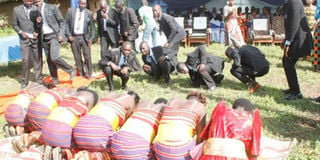Lango cultural chief issues new rules on traditional marriages

Men search for the bride-to-be during a Lango traditional marriage ceremony in Ojwina Division, Lira Municipality, last weekend. PHOTO BY ISAAC OTWII
LIRA- Sarah dropped out of school at 15 years and got married at only 16. Today, the 19-year-old Primary Seven dropout is blessed with a 9-month-old baby boy.
Living in Ogur Sub-county in Lira District, Sarah is among hundreds of teenage girls that have become mothers and also got married before reaching adulthood.
Teenage pregnancy rate in northern Uganda stands at 145 per 1,000 girls, according to the Uganda Demographic and Health Survey 2016. The National Population and Housing Census 2014 estimates that about 3,728 teenage girls were married off in Lira District, with Aromo Sub-county leading with 455 girls.
In January, Mr Joel Otwal, the headmaster of Walela Primary School in Aromo Sub-county, said 15 girls from his school, most of them in Primary Five and Six, were taken away by their parents in 2017 and later married off.
In a bid to fight the widespread child marriages, cultural leaders of Lango have now resolved that no traditional marriage shall be conducted without the approval of Won Nyaci, the paramount chief.
Resolution
Mr Benson Dila, the speaker of Lango Cultural Foundation, says they resolved on July 9 that all traditional marriages will only take place after being approved by the traditional leader. If such marriage is approved, the Lango Cultural Foundation will then issue a marriage certificate to the couple.
“We want to enforce this by first educating our community, presenting to them the context of the law and the cultural institution’s position on ending child marriages,” he says.
“We want to pronounce as Lango cultural institution that all girls getting married have to be issued with certificates and any marriage involving girls under 18 years will not be certified by the cultural institution,” Mr Dila adds.
Article 34 of the 1995 Constitution defines a child as a person under the age of 16 years, while Section 31 of the Child’s Rights Act 2003, sets the age of consent at 18 years. Also, sections 21 and 22 of the same Act prohibit child marriage or betrothal.
The secretary for community-based services in Lira, Ms Medina Okeng, welcomes the move, saying fighting child marriage has been a challenge because cultural leaders often cover up such abuses.
Similarly, Lira District youth councillor James Omara Elem commends the move but urges Lango Cultural Foundation leaders and parents to change their attitudes towards girl education.
“Through the clan leaders, I believe child marriages can be no more if they change their attitude as they have started. I have never heard of them (clan leaders) coming out to talk about ending child marriage, but I am now happy that they are committed to ending the vice,” he says.
Mr Morris Chris Ongom, the executive director of Global Forum for Development (GLOFORD), a non-governmental organisation, says arranged marriages for adolescent girls without their consent are commonly practiced in Uganda, especially in rural areas.
Ms Betty Alyela, a parent in Lira Town, says the practice of girls being married off before they are 18 puts them at risk of abuse, domestic violence and health problems.
She says the new initiative by the Lango Cultural Foundation will protect many girls from such problems.
The North Kyoga region police spokesperson, Mr David Ongom Mudong, also applauds the cultural leaders for coming up with the new initiative.
“I am happy that the cultural leaders in Lango are now coming in to help fight child marriages,” he says.
Lango’s norms
Nyom (marriage) in Lango is a lengthy process which begins with a boy seeing a girl and starting to court her. She is typically expected to be timid and hard to get in order to protect her morally upright reputation. The boy eventually wins her over after several encounters.
The girl informs her parents who in turn inquire about the boy’s clan in order to verify that the two love birds are not related by blood. The young man chiefly depends on his lineage to get the permission to marry a girl and the ability to provide the material goods required to pay her bride price. When the boy’s family agrees, he is given a green light to marry the girl.



